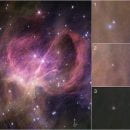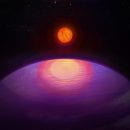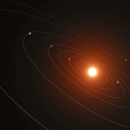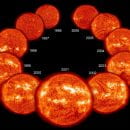Unveiling the secrets of planet formation in environments of high UV radiation
Astronomers at Penn State use data from NASA’s James Webb Space Telescope and theoretical modeling to study a distant, irradiated...
Read MoreCombination of cosmic processes shapes the size and location of sub-Neptunes
Penn State Presidential and CEHW Postdoc Dr. Rachel Fernandes led a study to better understand the processes shapes the size and location...
Read MoreWobbling stars reveal hidden companions in Gaia data
Using data from the European Space Agency’s Gaia mission, and the Habitable Zone Planet Finder and NEID Spectrometers developed at Penn...
Read MoreCEHW researchers characterize the internal composition of a distant planet
CEHW Graduate student Nick Tusay led a JWST program to measure the mineralogical composition of an exoplanet, K2-22b, and presented his...
Read MoreNew planet in Kepler-51 system discovered using James Webb Space Telescope
The unusual system of three ‘super puff’ planets has at least one more planet, revealed by its gravitational tug on other...
Read MoreJWST identifies tiniest free-floating brown dwarf
CEHW Professor Kevin Luhman led a study identifying the new record-holder for the smallest object that forms like a star: a tiny,...
Read MoreMassive planet too big for its own sun pushes astronomers to rethink exoplanet formation
Congrats to former CEHW graduate student, Dr. Gudmundur Stefansson, and the rest of the team on their recent paper in Science that reports...
Read MoreEarth-like planets could form even in the harshest environments
CEHW Professor Eric Feigelson is a member of the XUE (eXtreme UV environments) collaboration that found potentially planets with water...
Read MoreMany exoplanets have nearly circular orbits
New analysis of observational data from NASA’s Kepler space telescope catalogs planetary properties; informs climate of planets Most...
Read MoreNearby star could help explain why our sun didn’t have sunspots for 70 years
CEHW undergrad alumna Anna Baum and Prof. Jason Wright identified a nearby star whose sunspot cycles appear to have stopped. Read more in...
Read More












